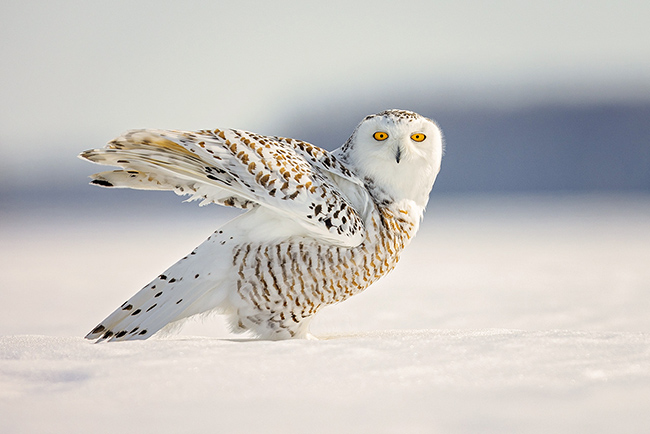Snowy Owls: The Arctic’s Silent Hunter
The Snowy Owl (Bubo scandiacus) is a remarkable bird that inhabits cold, northern regions and is famous for its striking white plumage. Native to the Arctic, it is widely admired for its beauty, hunting skills, and adaptability. The Snowy Owl gained global popularity through the “Harry Potter” series, where Harry Potter’s pet owl, Hedwig, was a Snowy Owl.
Physical Appearance
Snowy Owls are medium to large birds. Males are almost entirely white, while females have black or brown markings. They have large, bright yellow eyes that help them hunt even at night. Their legs and feet are densely feathered, acting like natural mittens to protect them from extreme cold.
A Snowy Owl can grow 51–70 cm in length, with a wingspan of 130–165 cm. They typically weigh between 1.5–3 kg, and their wingspan can reach approximately 4.5–5.5 feet.
Habitat and Range
Snowy Owls are found in Arctic regions, including northern Canada, Alaska, Greenland, and northern Eurasia. In summer, they inhabit open, snow-covered tundra areas. During winter, they sometimes migrate south in search of food, reaching parts of the United States and Europe. This seasonal movement, called an “irruption,” does not happen every year but occurs when food is scarce.
Diet and Hunting
Snowy Owls are primarily carnivorous. Their main prey is lemmings, small mammals abundant in the Arctic. In summer, an adult Snowy Owl can eat 5–6 lemmings per day. They also hunt rabbits, mice, birds, and occasionally fish.
These owls are precise hunters. They perch on low trees, hills, or snow-covered terrain and swoop down on their prey. Their acute vision and hearing allow them to hunt effectively even in darkness and snowy conditions.
Reproduction and Breeding
During the summer, Snowy Owls nest in elevated areas of the tundra. Females lay 3–11 eggs in shallow ground nests, with the number of eggs depending on the abundance of lemmings that year.
The female incubates the eggs while the male provides food. Eggs hatch in 32–34 days. Hatchlings are initially blind and weak, but they can walk within 20–25 days and learn to fly in about seven weeks.
Social Behavior
Snowy Owls are generally solitary and defend their territory against other owls. However, in times of food scarcity or during winter, they may gather in groups.
They sometimes appear near human settlements, especially during harsh winters. Human activity and environmental changes can pose threats to them.
Threats and Conservation
Although currently listed as “Least Concern” by the IUCN, Snowy Owls face threats from climate change, habitat destruction, food scarcity, and hunting.
Warming in the Arctic affects lemming populations, creating food shortages for Snowy Owls. Illegal hunting and collisions with power lines are additional causes of mortality.
Hybrid Species
Snowy Owls generally do not interbreed with other owl species, and wild hybrids are rare. However, in 2013, in Cologne, Germany, a male Snowy Owl and a female Eurasian Eagle Owl (Bubo bubo) produced hybrid offspring.
The male hybrid owls had dark markings like their Eurasian Eagle Owl mother but retained the black-and-white coloring of their Snowy Owl father. These hybrids were called “Schnuhus” in German and were healthy by 2014.
Snowy Owl in Culture
Snowy Owls are symbols of wisdom, mystery, and nocturnal power in many cultures. They appear prominently in Western literature, fiction, and films. The “Harry Potter” series, featuring Hedwig, brought global attention to this species.
The Snowy Owl is a unique creation of nature. Its white beauty, powerful hunting skills, and adaptability to harsh climates make it a remarkable bird. It is our responsibility to protect this rare species, conserve its habitat, and raise awareness of the impacts of climate change. The Snowy Owl is not just a bird of the snow—it is a silent hunter and an important part of nature’s balance.
Sources:
Cornell Lab of Ornithology
National Geographic
Smithsonian’s National Zoo & Conservation Biology Institute – Snowy Owl Profile
Audubon Society – Snowy Owl Conservation and Irruption Patterns
Encyclopedia of Life (EOL) – Bubo scandiacus

